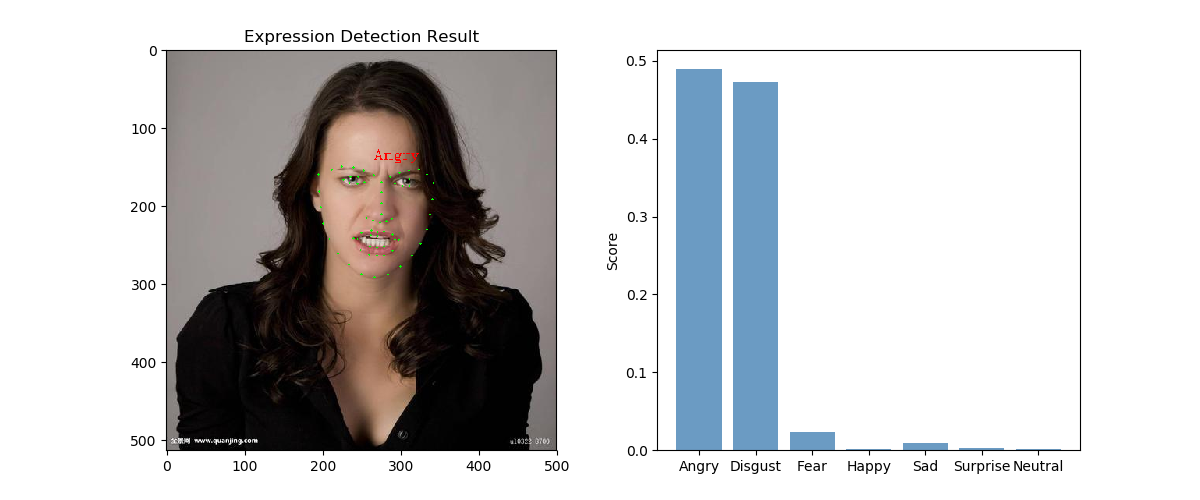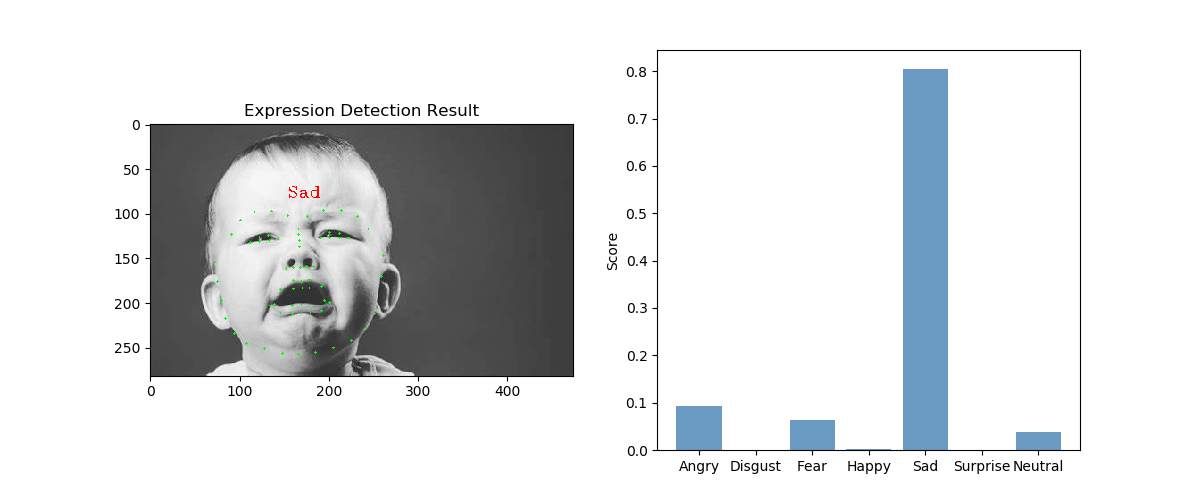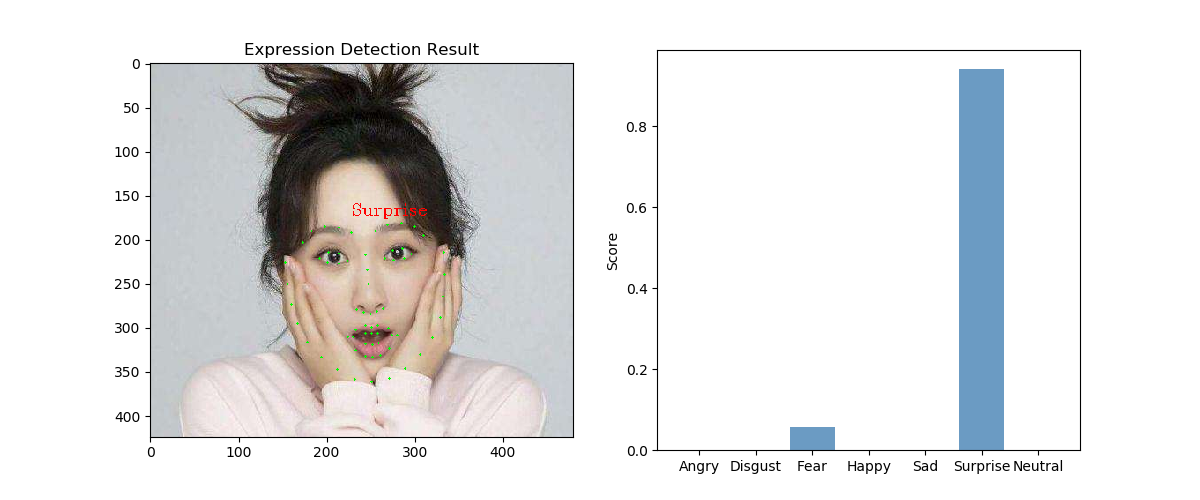Facial Expression Rcognition(FER) based on deep convolutional neural network(CNN).
FER2013 Challenges in Representation Learning: Facial Expression Recognition Challenge
Download fer2013.csv and put it into ./data
Based on VGG16, with GaussianNoise, and simpler fully-connected layers in the top.
main_input = layers.Input([config.img_size, config.img_size, 1])
x = layers.BatchNormalization()(main_input)
x = layers.GaussianNoise(0.01)(x)
base_model = VGG16(weights=None, input_tensor=x, include_top=False)
# flatten = layers.GlobalAveragePooling2D()(base_model.output)
flatten = Flatten()(base_model.output)
fc = Dense(2048, activation='relu',
kernel_regularizer=l2(0.001),
bias_regularizer=l2(0.001),
)(flatten)
fc = Dropout(dropout_rate)(fc)
fc = Dense(2048, activation='relu',
kernel_regularizer=l2(0.001),
bias_regularizer=l2(0.001),
)(fc)
fc = Dropout(dropout_rate)(fc)
predictions = Dense(config.class_num, activation="softmax")(fc)
model = keras.Model(inputs=main_input, outputs=predictions, name='vgg16')
optimizer = keras.optimizers.Adam(lr)
model.compile(loss='categorical_crossentropy',
optimizer=optimizer,
metrics=['categorical_accuracy'])
return modelUsage: python preprocess.py
Origin csv file is converted to images.
Facial part of the image is detected and extracted by Dlib and Opencv2.
Then resize to original size(48*48).
Several pickle files contain each image path and label.
def crop_face_area(detector, landmark_predictor, image, img_size):
p_img = Image.fromarray(image).convert(mode='RGB')
cv_img = cv2.cvtColor(np.asarray(p_img), cv2.COLOR_RGB2GRAY)
faces = detector(cv_img, 1)
all_landmarks = []
all_faces = []
if len(faces) > 0:
for face in faces:
shape = landmark_predictor(cv_img, face)
landmarks = np.ndarray(shape=[68, 2])
for i in range(68):
landmarks[i] = (shape.part(i).x, shape.part(i).y)
all_landmarks.append(landmarks)
x1, y1, x2, y2 = face.left(), face.top(), face.right(), face.bottom()
if x1 < 0:
x1 = 0
if x1 > cv_img.shape[1]:
x1 = cv_img.shape[1]
if x2 < 0:
x2 = 0
if x2 > cv_img.shape[1]:
x2 = cv_img.shape[1]
if y1 < 0:
y1 = 0
if y1 > cv_img.shape[0]:
y1 = cv_img.shape[0]
if y2 < 0:
y2 = 0
if y2 > cv_img.shape[0]:
y2 = cv_img.shape[0]
img = cv2.resize(cv_img[y1:y2, x1:x2], (img_size, img_size))
all_faces.append(img)
return np.asarray(all_faces), np.asarray(all_landmarks)
else:
return None, NoneAfter running the script, you should get the following files.
shape_predictor_68_face_landmarks.dat is downloaded from davisking/dlib-models
│ fer2013.csv
│ shape_predictor_68_face_landmarks.dat
│ test.pickle
│ test_landmark.npz
│ train.pickle
│ train_landmark.npz
│ valid.pickle
│ valid_landmark.npz
│ __init__.py
├─test
├─train
└─valid
train_datagen = ImageDataGenerator(
samplewise_center=True,
samplewise_std_normalization=True,
brightness_range=(0.8, 1.2),
rotation_range=10,
width_shift_range=0.1,
height_shift_range=0.1,
zoom_range=0.1,
horizontal_flip=True,
)Training and validation is performed on FER2013's Train and PrivateTest samples.
- LR: 1e-4
- Batch size: 128
- Optimizer: Adam
- Dropout rate: 0.5
- Early stopping: monitor on validation loss with patience 6
- Learning rate reduce: factor 0.1 with patience 4
Usage:
python train.py -h
usage: train.py [-h] [-dropout DROPOUT_RATE] [-lr LEARNING_RATE]
[-batch_size BATCH_SIZE] [-model MODEL_NAME]
optional arguments:
-h, --help show this help message and exit
-dropout DROPOUT_RATE, --dropout_rate DROPOUT_RATE
The dropout rate for the last dense layers.Default
0.5.
-lr LEARNING_RATE, --learning_rate LEARNING_RATE
Learning rate. Default 1e-3.
-batch_size BATCH_SIZE, --batch_size BATCH_SIZE
Batch size. Default 128.
-model MODEL_NAME, --model_name MODEL_NAME
The classification model. Default vgg16.
Test the performance on FER2013's PublicTest samples.
- Test-time augmentation: 10
Usage
python test.py -h
usage: test.py [-h] [-tta TTA] [-batch_size BATCH_SIZE] [-model MODEL_NAME]
optional arguments:
-h, --help show this help message and exit
-tta TTA, --tta TTA Test-time augmentation times. Default 5.
-batch_size BATCH_SIZE, --batch_size BATCH_SIZE
Batch size. Default 128.
-model MODEL_NAME, --model_name MODEL_NAME
The classification model. Default vgg16.
Usage:
python detect.py -h
usage: detect.py [-h] [-tta TTA] [-model MODEL_NAME] [-cam CAMERA]
[-path IMAGE_PATH]
optional arguments:
-h, --help show this help message and exit
-tta TTA, --tta TTA Test-time augmentation times. Default 5.
-model MODEL_NAME, --model_name MODEL_NAME
The classification model. Default vgg16.
-cam CAMERA, --camera CAMERA
Whether to detect face using camera. Default False
-path IMAGE_PATH, --image_path IMAGE_PATH
The path of the image. Only useful when -cam=false.
f1 score: 0.6667545793929432, acc: 0.6682750301568154, recall: 0.6682750301568154
- python 3.6.5
- tensorflow 1.13.1
- keras 2.2.4
- dlib
- opencv






